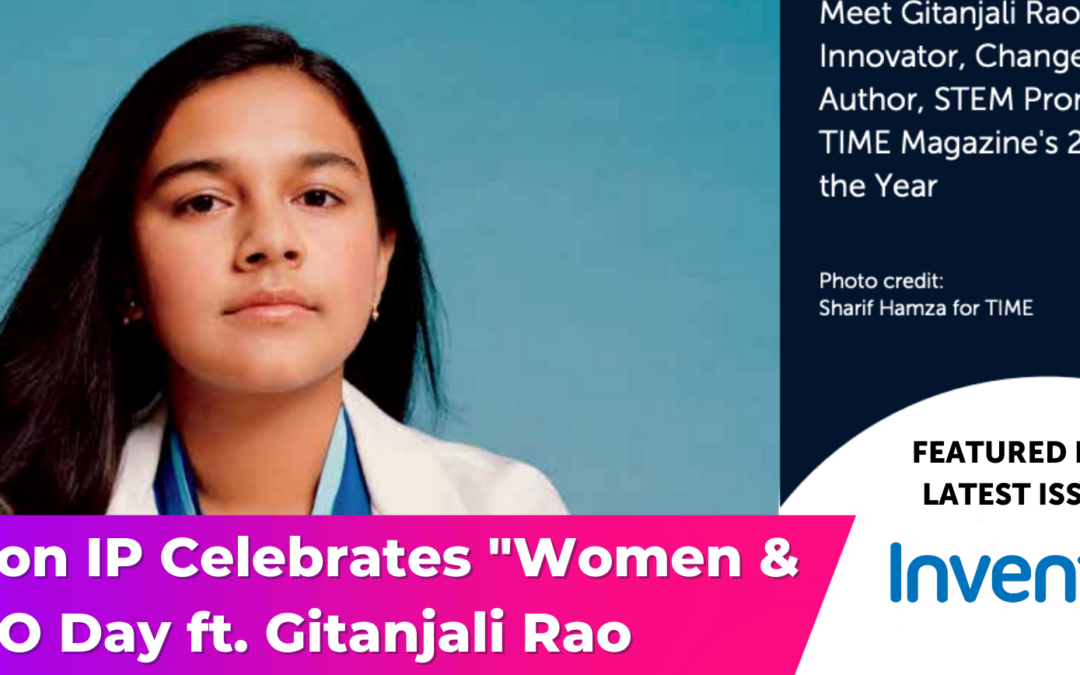In honor of this year’s World IP Day and its 2023 “Women & IP” theme–with global celebrations taking place on April 26th–Michelson IP presents this extraordinary piece on young woman inventor Gitanjali Rao for Inventors Digest.
Battling Bias —KINDLY: 17-Year-Old Innovator Gitanjali Rao Is Helping To Change Gender Perception, And The World
BY MADELEINE KEY
A CROSS THE innovation ecosystem, empowering women to embrace their inventiveness and act on their ideas has become a priority. Increasing women’s participation in innovation will produce substantial economic benefits. It will also improve outcomes for women, as research shows that female inventors are more likely to patent solutions to problems that specifically or disproportionately affect women. According to the World Intellectual Property Office, 16.2 percent of inventors named in international patent applications are women. Although women make up a greater percentage of new inventors in the United States than ever before, a gender gap in the patent system persists. To affirm their commitment to increasing the participation of women and girls in innovation and technology, more than 35 intellectual property offices issued a joint statement on International Women’s Day, March 8.
Women have always been inventors. Historically, though, their contributions to technology and innovation have been undercounted. Because U.S. patents do not include information about gender, identifying women inventors isn’t straightforward. In 1888, due to the persistent activism of publisher and journalist Charlotte Smith, four Patent Office clerks compiled and published the first list of female inventors to earn U.S. patents. A century later, scholar Autumn Stanley revealed how imperfect the clerks’ work was. In one year alone, she identified 33 patentees with unmistakably female names who weren’t on the list.
“Stanley suspects that the clerk-compilers, upon finding a woman’s name associated with an industrial invention, simply assumed that it could not be true and omitted these patents from the list,” wrote historian Eric S. Hintz at the Lemelson Center for the Study of Invention and Innovation at the Smithsonian.
Learning through challenges
Gitanjali Rao, the world-renowned 17-year-old inventor, scientist, educator, author, and public speaker, wouldn’t be surprised to learn that. As an advocate for innovation, she understands the difficulties faced by women and people from other underrepresented groups, including bias. In 2017, when she was 12, Rao won 3M’s Young Scientist Challenge for her invention of Tethys, a cheaper and faster tool for detecting the presence of lead in water inspired by the crisis in Flint, Michigan.
In a dazzling TED talk around the same time, she animatedly explained how she drilled down on the problem she wanted to solve; researched the marketplace for solutions; was inspired by the latest developments in nanotechnology; developed a prototype; and continues to improve her device, which she describes as cheaper and faster than other options. Since then, she has worked on nearly a dozen innovations—three that have been developed into fully functioning prototypes—and one she commercialized in partnership with UNICEF. Kindly, her idea to combat meanness, is an open-source interface that uses machine learning to detect cyberbullying intent. It’s available worldwide for use on Discord, Slack, Instagram, and Chrome.
Continue reading on page 26 of Inventors Digest…
_________
 The Michelson Institute for Intellectual Property, an initiative of the Michelson 20MM Foundation, provides access to empowering IP education for budding inventors and entrepreneurs. Michelson 20MM was founded thanks to the generous support of renowned spinal surgeon Dr. Gary K. Michelson and Alya Michelson. To learn more, visit 20mm.org.
The Michelson Institute for Intellectual Property, an initiative of the Michelson 20MM Foundation, provides access to empowering IP education for budding inventors and entrepreneurs. Michelson 20MM was founded thanks to the generous support of renowned spinal surgeon Dr. Gary K. Michelson and Alya Michelson. To learn more, visit 20mm.org.
